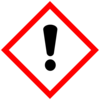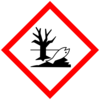In Australia, hazardous chemicals in the workplace must be labeled according to the GHS (Globally Harmonised System of Classification and Labelling of Chemicals). These internationally recognised symbols and statements enable anyone using the chemicals to quickly identify the hazards and take steps to minimise (or completely eliminate) any risks to work health and safety. This blog helps you understand the full meaning of the pictograms (eg, flame, bomb, dead fish), signal words (DANGER, WARNING) and hazard codes/statements (eg, H240 Heating may cause an explosion) found on chemical labels and placards.
IMPORTANT: A label is required for any substance, mixture or article classified as a hazardous chemical under Australian WHS Regulations. There is a small range of substances exempted from labelling — these are usually products manufactured for human consumption in a domestic situation (eg, 700ml bottles of alcohol and therapeutic medicines).
HAZCHEM Placards
If the hazardous chemicals kept at your workplace exceed certain quantities (also known as placard quantities) you are required by the WHS Regulations to display the HAZCHEM placard (and others) at the entrance to your worksite. The Regulations set out the design of the placard which must have:
-
The words HAZCHEM in UPPERCASE text
-
Red lettering
-
Text at least 100 mm high
-
A white or silver background
IMPORTANT: A placard is a notice or sign displayed in a prominent place: at the entrance to a workplace; next to a container; or in a hazardous chemical storage area. It contains information about the hazardous chemicals inside the containers or stored nearby.
Pictograms
Chemical pictograms are internationally understood symbols and icons that describe a substance’s primary hazard class — ie, the physical, health, and environmental hazards. The GHS specifies nine different hazard pictograms in a standardised format and they are used all over the world. The nine pictograms are a black symbol on a white background and diamond shaped (square and set at an angle of 45º). They have either a red or black border.
The symbols and codes include:
| Code | Class | Description | Pictogram | |
1. |
GHS01 |
|
(BOMB) |
 |
2. |
GHS02 |
Flammable |
(FLAMES) |
 |
3. |
GHS03 |
|
(FLAME OVER A TANK) |
 |
4. |
GHS04 |
Compressed Gas |
(GAS BOTTLE) |
 |
5. |
GHS05 |
Corrosive |
(TEST TUBE POURING CORROSIVE CHEMICAL) |
 |
6. |
GHS06 |
Toxic |
(SKULL AND CROSSBONES) |
 |
7. |
GHS07 |
Harmful |
(EXCLAMATION MARK) |
 |
8. |
GHS08 |
Health Hazard |
(HUMAN WITH BROKEN CHEST) |
 |
9. |
GHS09 |
Environmental Hazard |
(DEAD TREE, DEAD FISH) |
 |
GHS Pictograms vs ADG Code Pictograms
In Australia we have our own pictograms which are used when transporting dangerous goods (specified by the Australian Dangerous Goods Code). The ADG Code pictograms are based on the GHS symbols but add colours and design variations to identify the chemicals within their ADG sub-class.
Examples of ADG Code pictograms include:
-
4: Dangerous When Wet (Flames on a blue background)
-
2: Non-flammable, non-toxic gas (gas bottle on a green background)
-
4: Flammable Solid (Flames on a red and white striped background)
The ADG pictograms may be used on labels and placards instead of the GHS symbols when they both represent the same hazard. For example a flammable gas like LPG could carry the GHS pictogram GHS02: Flammable (FLAMES) or the ADG Code pictogram 2: Flammable Gas (Flames on a red background).
Individual storage areas where hazardous chemicals are kept should display an information placard with the appropriate pictogram. If the worksite carries larger quantities of chemicals (ie above placard quantities), the placards are mandatory.
TIP: All STOREMASTA chemical stores and safety cabinets arrive complete with mandatory signage and placards in place.
Signal Words
Under the GHS, each hazardous chemical is assigned one ‘Signal Word’ of either DANGER or WARNING according to its hazard class. Because these signal words are used to quickly indicate the severity of a hazard, a chemical is assigned only ONE signal word. Signal words are required on labels.
The word DANGER is used for more severe and significant hazards, while the word WARNING is used for the less severe hazards. Signal words are always represented in bold and UPPERCASE text and many placards display the DANGER signal word in white text over a red — on a black background.
Other chemical labels
Hazard Statements
Every hazard class has a unique hazard statement and code that is standardised under the GHS. These hazard statements describe the nature of a hazard in a short phrase or sentence. Hazard statements must be included on chemical labels in bold type. Examples include:
-
H220 Extremely flammable gas
-
H280 Contains gas under pressure; may explode if heated
-
H224 Extremely flammable liquid and vapour
Precautionary Statements
Precautionary statements support the hazard statement and pictogram and can assist you in:
-
Preventing chemical accidents and exposure ( eg, P240 Ground/bond container and receiving equipment)
-
Responding to chemical emergencies (eg, P336 Thaw frosted parts with lukewarm water. Do not rub affected area)
-
Safely storing the chemicals (eg, P403 Store in well-ventilated place)
-
Disposing of the chemical safely (eg, P501 Dispose of contents/container in accordance with local/regional/national regulations)
Precautionary statements are not necessarily linked to hazard classes and should be given a prominent position on chemical labels. You’ll also use them in assessing the overall risks to your workers in conjunction with your risk management plan.
IMPORTANT: Controlling the risks associated with hazardous chemicals requires more than following the precautionary statements on the product label or SDS. You must carefully assess the risk associated with every chemical hazard and implement suitable (and compliant) control measures.
Next Steps
Having the correct chemical labels and signage at your worksite is only one aspect of WHS compliance. To learn more about your responsibilities and how to control chemical hazards, we recommend downloading our free eBook How to manage the risk of Hazardous Chemicals in the workplace. Read it today.
Joining the team as a Dangerous Goods Storage Consultant, Melissa Hampton became Storemasta's Marketing Manager in late 2021. With extensive knowledge and experience in chemical compliance, Melissa is responsible for leading the Marketing team and helping shape their marketing strategy. In her spare time, you can find Melissa hiking, swimming and enjoying the great outdoors in beautiful north-west Tasmania.
